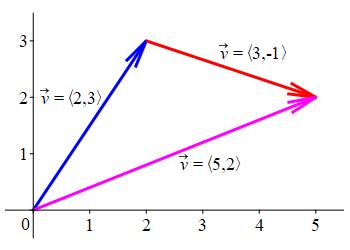5. Vectors
b. Vector Addition
1. Algebraic Definition
Whenever we introduce a new operation, we first give an algebraic definition. Then we derive an equivalent geometrical formula. And finally, we look at its properties and see how it relates to previously defined operations. We start with vector addition:
The sum of two vectors is computed by finding the sum of their corresponding components. Thus, if \(\vec u=\left\langle u_1,u_2\right\rangle\) and \(\vec v=\left\langle v_1,v_2\right\rangle\), then their sum is: \[ \vec u+\vec v=\left\langle u_1+v_1,u_2+v_2\right\rangle \]
If a particle moves \(2\) units east and \(3\) units north, then the vector to describe this motion is \(\vec u=\left\langle2,3\right\rangle\). If it then moves \(3\) units east and \(1\) unit south, the vector to describe this second motion is \(\vec v=\left\langle3,-1\right\rangle\). Overall, the total motion is \(5\) units east and \(2\) units north, which is the sum: \[ \vec u+\vec v=\left\langle2,3\right\rangle+\left\langle3,-1\right\rangle =\left\langle5,2\right\rangle \] Here is a diagram.

If \(\vec u=\left\langle-2,4\right\rangle\) and \(\vec v=\left\langle4,2\right\rangle\) compute \(\vec u+\vec v\).
\( \vec u+\vec v=\left\langle2,6\right\rangle \)
\[\begin{aligned} \vec u+\vec v &=\left\langle-2,4\right\rangle+\left\langle4,2\right\rangle \\ &=\left\langle2,6\right\rangle \end{aligned}\]
Notice that the algebraic formula shows that vector addition is commutative since: \[\begin{aligned} \vec v+\vec u &=\left\langle v_1+u_1,v_2+u_2,v_3+u_3\right\rangle \\ &=\left\langle u_1+v_1,u_2+v_2,u_3+v_3\right\rangle =\vec u+\vec v \end{aligned}\]
Heading
Placeholder text: Lorem ipsum Lorem ipsum Lorem ipsum Lorem ipsum Lorem ipsum Lorem ipsum Lorem ipsum Lorem ipsum Lorem ipsum Lorem ipsum Lorem ipsum Lorem ipsum Lorem ipsum Lorem ipsum Lorem ipsum Lorem ipsum Lorem ipsum Lorem ipsum Lorem ipsum Lorem ipsum Lorem ipsum Lorem ipsum Lorem ipsum Lorem ipsum Lorem ipsum